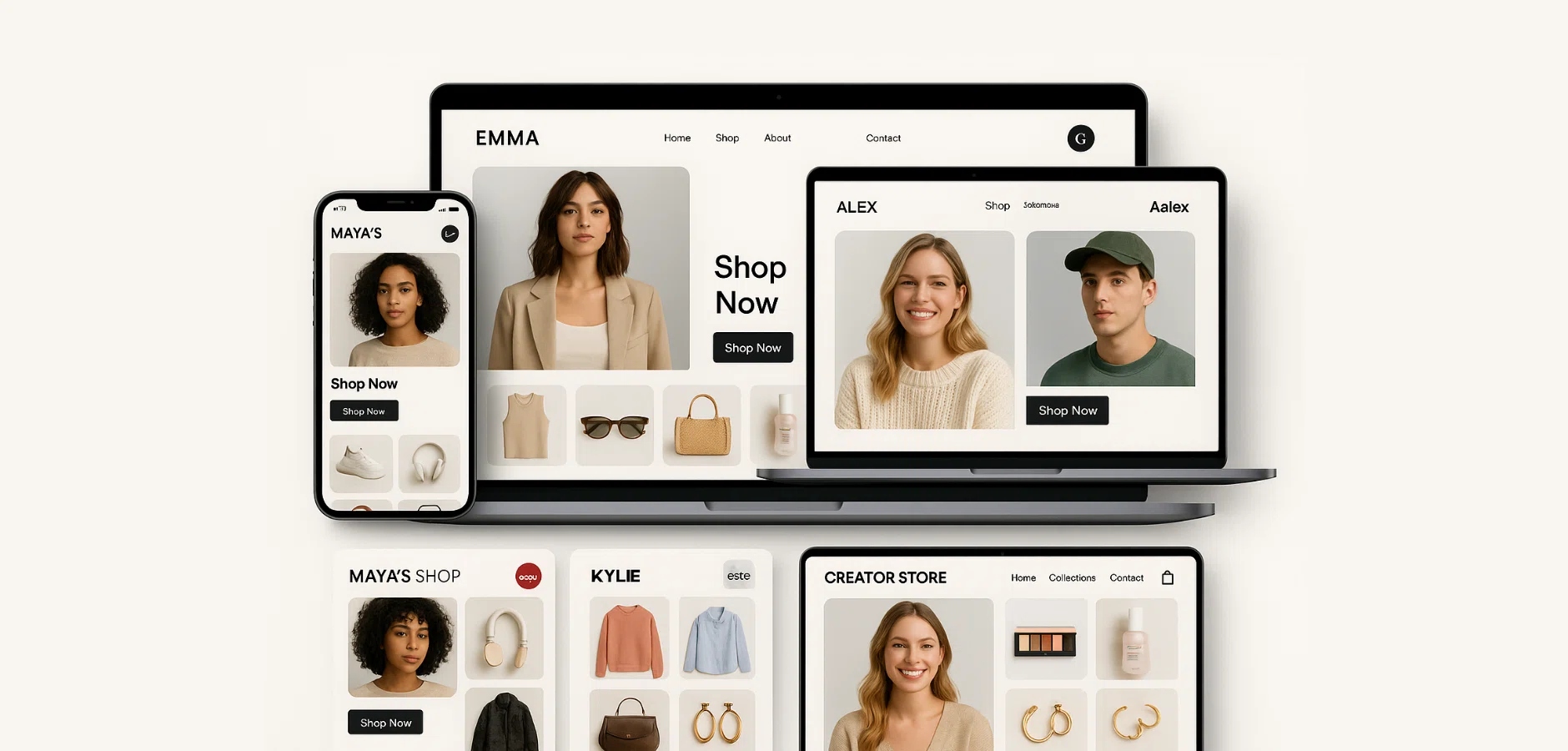Creator commerce has changed how brands connect with consumers. At its core, content creators use their influence to drive product sales and build meaningful brand collaborations.
More than one in three brands will focus on creator-audience dynamics in 2025. Branded storefronts are the next piece of the puzzle.
These storefronts combine influencer marketing with personalized product offerings and engaging shopping experiences, giving creators the power to convert interest into action, and brands a new way to boost customer loyalty.
Fully customizable in look and feel, branded storefronts reflect brand and creator identity, from colors and fonts to curated product picks.
Consumers are already on board: 61 percent who discover a product online will later purchase it on an ecommerce marketplace. Branded storefronts meet that demand, giving brands new ways to scale creator partnerships.
Fabletics nails it with its “Influencer Hot List.” Customers can shop real-life creator looks, see products in action, and add items directly to their cart. It’s more engaging than traditional product pages—and a glimpse into the future of creator-led commerce.
- In this blog, we’ll explore:
- How branded storefronts work and the trailblazing brands setting the standard
- The advantages branded storefronts offer to brands, creators, and consumers
- Strategies for leveraging branded stores to achieve meaningful results through creator partnerships

Branded storefronts seamlessly guide customers from product discovery to purchase, particularly when they already show interest in a product.
Beyond a marketing strategy, branded storefronts reach customers where they are
Traditional e-commerce often relies on broad, impersonal campaigns. Branded storefronts take a different approach. By giving creators their own curated shopping pages, brands can connect with niche audiences through content that feels personal and trustworthy.
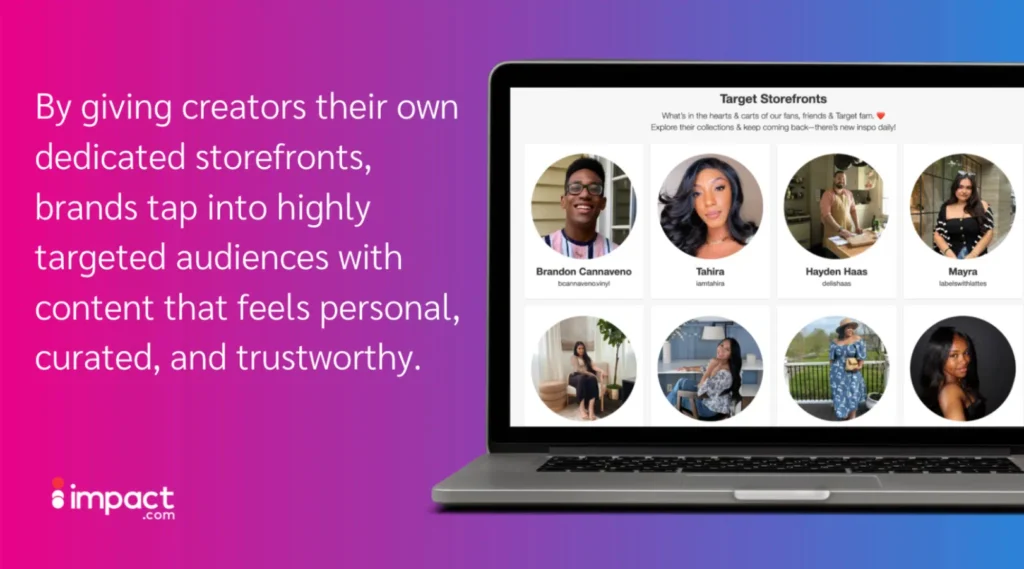
Branded storefronts create a sense of personalization and trust, encouraging audiences to explore and purchase carefully curated products from their favorite creators.
Target regularly partners with creators to build customized storefronts. Hayden Haas (@delishaas) is a recipe developer with 800k+ TikTok followers. His Target Storefront features the exact kitchen tools, pantry staples, and home goods he uses in his videos, making it easy for fans to shop with confidence and inspiration.
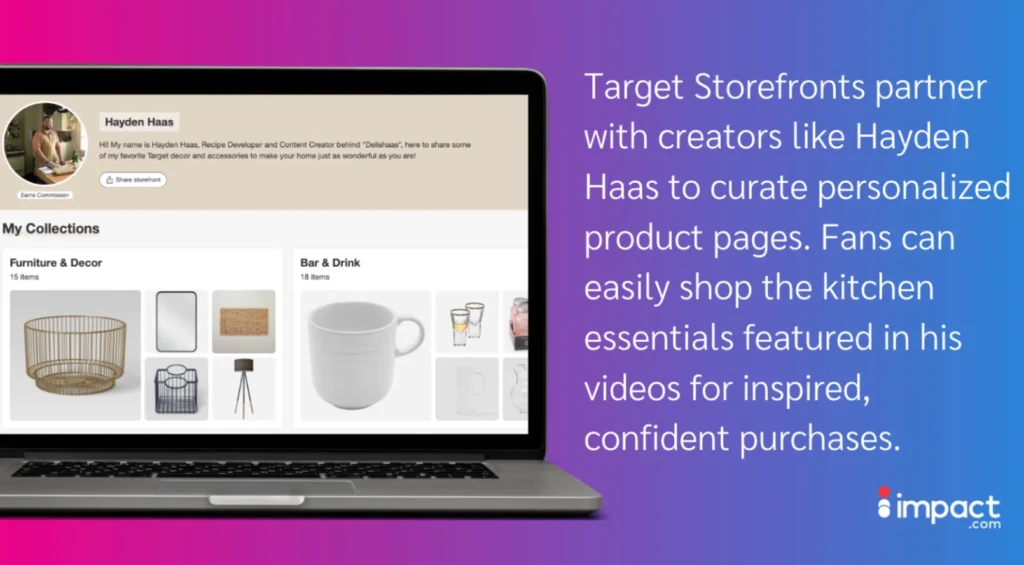
Target Storefronts transformed Hayden Haas’ genuine connection with his audience into a thoughtfully curated collection of essential kitchen items.
Why a branded storefront is a win-win for Hayden Haas, his followers, and Target
This kind of partnership creates value across the board. For Target, Hayden’s storefront delivers higher conversion rates by reaching an already engaged audience.
His followers trust his content, so when they see the exact kitchen tools or pantry staples he uses in his videos, they’re more likely to click and buy.
For Hayden, the storefront is a monetization tool and a way to deepen loyalty. He earns commission on every sale while building stronger connections with followers who appreciate curated, useful recommendations. It also gives him a platform to showcase his personal style in a more permanent, shoppable way.
And for his fans, the shopping becomes frictionless. They don’t have to hunt for the tools he used in a recipe video or guess where to buy a certain product. Everything’s in one place, often with affiliate perks or exclusive discounts. It feels less like an ad, and more like a personalized shortcut to the things they already want.
Branded storefronts strengthen brand-creator partnerships
In the past, creators were often brought in for one-off campaigns. They promoted a product, then moved on. But branded storefronts are changing that model.
Now, creators become true partners in a brand’s success. They get dedicated space to curate and sell the products they genuinely love, building stronger, more sustained collaborations.
ColourPop partners with top makeup artists, giving them the freedom to design custom storefronts. These creators use insider knowledge and a close connection with followers to highlight products that resonate.
Micro-influencers and brand ambassadors excel in this space. With their niche, highly engaged communities that trust their recommendations, they often drive higher conversions and foster stronger brand loyalty. This year, more brands are recruiting micro-influencers to connect with audiences.
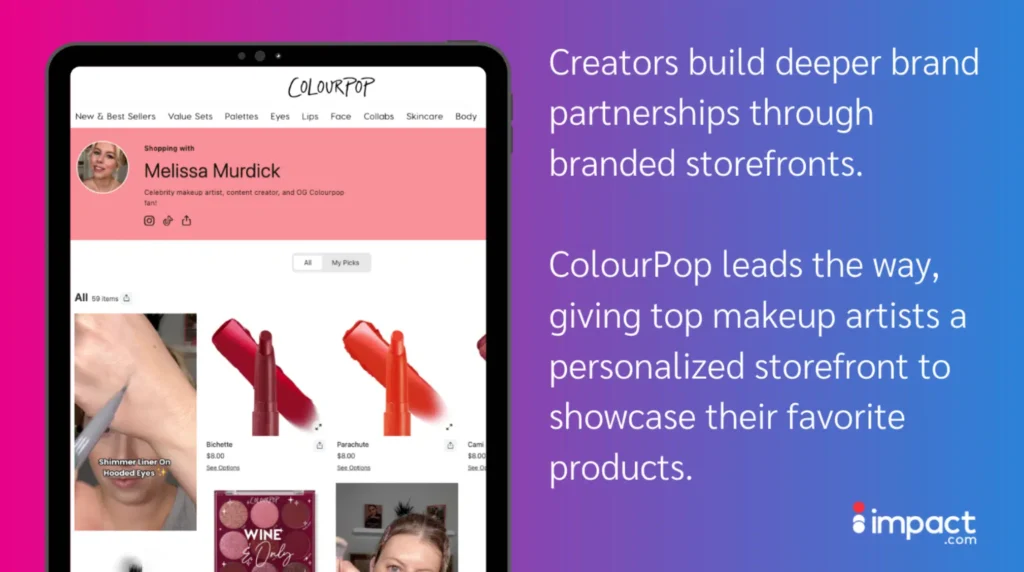
Colourpop gives top makeup artists the space to get creative and craft their dream storefront—and consumers love it.
Creator commerce aligns with evolving customer shopping habits
Today’s consumers don’t stop at browsing. They’re scrolling, tapping, and buying in the same motion. According to eMarketer, nearly half of consumers prioritize speed when completing transactions, while 44 percent rank convenience as their top shopping priority.
Creator commerce blends entertainment and convenience by meeting shoppers where they spend their time, on social media.
With tools like Instagram Shops and TikTok Storefronts, brands can sell products directly in-app.
It’s a strategy that works: eMarketer revealed that 56 percent of social media users made purchases after seeing creator content through a platform’s shopping features.
Here’s why: Customers can browse curated collections, use influencer discount codes, or even save items for later without leaving their feed.
Soludos, known for its iconic espadrilles, uses Instagram Shopping to showcase products through lifestyle content. By pairing shoppable tags with authentic storytelling, Soludos keeps the experience engaging and community-driven, not overly salesy.
Creator commerce is how shopping looks today. Branded storefronts give creators the tools to guide their followers from inspiration to purchase, all within an intuitive social-first experience.

Shopping with Soludos is effortless on Instagram Shopping: Browse, tap to learn more, and complete your purchase with ease.
3 ways branded storefronts tap into modern shopping habits
Branded storefronts fit right into how people shop today—fast, social, and on their terms.
They make the whole experience feel more personal, more fun, and way easier to act on.
1. Seamless shopping experiences
Today’s consumers expect a frictionless path from discovery to checkout.
Branded storefronts make it easy to go from watching a creator’s content to purchasing a featured product, without leaving the platform.
It’s a natural extension of how people already engage with content.
2. Convenience and instant gratification
Younger shoppers crave instant access to products they love, with many embracing personalized, AI-driven recommendations. This highlights the growing demand for both convenience and tailored shopping experiences.
Branded storefronts make it easy for shoppers to go from inspired to checkout in seconds.
With payment and shipping details already saved, buying takes just a few taps, turning impulse into action.
3. Deeper brand engagement
Storefronts keep fans coming back.
From exclusive drops to newsletter sign-ups, they give shoppers more ways to stay connected, and give brands a direct line to their biggest fans.
Why branded storefronts work for everyone: brands, creators, and consumers
Branded storefronts aren’t just a win for brands. They create value across the entire ecosystem. From stronger customer experiences to deeper creator partnerships, here’s how storefronts deliver measurable impact for every player involved.
Branded storefronts give brands control and consistency
Branded storefronts give businesses full control over how their products appear. It helps brands maintain a few key elements of their brand, including:
- Consistent messaging
- Polished visuals
- Strategic cross-sells across every channel
Brands can guide the entire shopping experience by:
- Highlighting new launches
- Bundling fan favorites
- Creating a smooth and engaging journey for customers
Beverage brand Polar Seltzer regularly releases limited-edition seasonal flavors, like the Summer 2025 Collection featuring Passionfruit-O-Guava and Poolside Grape Pops.
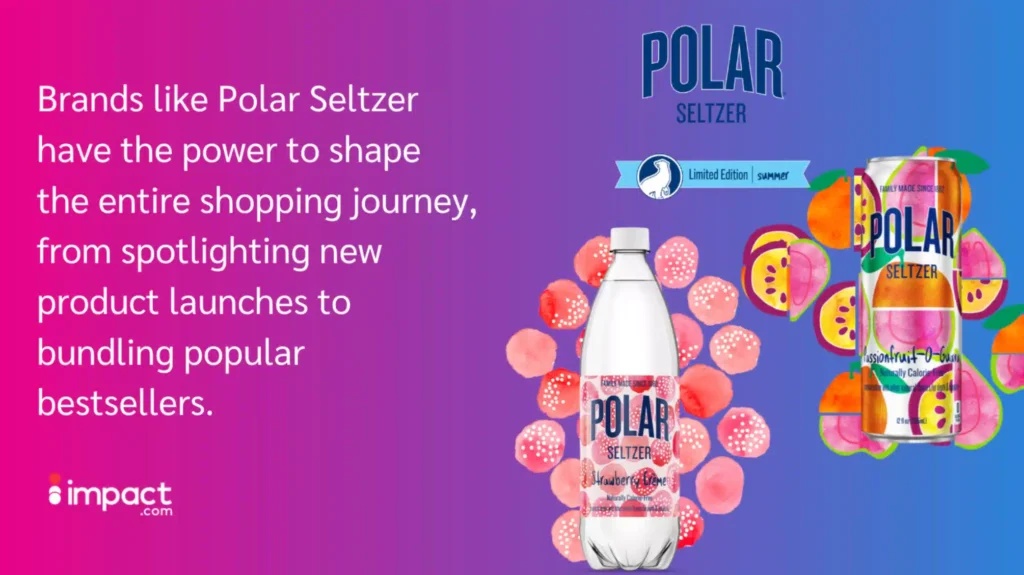
Polar Seltzer’s Summer 2025 Collection sparked renewed excitement for the brand, captivating consumers eager to explore its new flavors while reinforcing their connection to the brand.
These refreshing, on-theme flavors help the brand capture attention and boost sales during key seasonal moments.
If Polar Seltzer launched a branded storefront, it could highlight limited-time campaigns and build even more buzz around them.
Branded storefronts help creators monetize content through authenticity
Branded storefronts give creators more than just commission. They offer a space to showcase their voice and personal brand. By adding tutorials, reviews, and themed collections, creators build trust with their audience and increase visibility for the brand.
In December 2024, Hailey Bieber, founder of Rhode Skin, shared her quick and simple Christmas makeup routine on TikTok. The look featured products from her brand, including a new lip liner she teased during the tutorial.
She also incorporated a Fenty highlighter as eyeshadow, showcasing a festive glow. The authentic, shoppable content resonated with her audience, driving interest and sales during the holiday season.

Hailey Bieber seamlessly combines personal connection with commerce, presenting her brand’s latest products through an exclusive try-on experience.
Branded storefronts make buying easier for consumers
Shoppers get a smooth, easy experience from their first glance to checkout. Branded storefronts offer a consistent look and feel, personalized picks, and social proof that builds trust. The result is shopping feels effortless and fun.
Imagine a returning customer landing on a brand’s storefront. They see product suggestions based on their past purchases, along with a limited-time discount that encourages them to buy again.
It’s a simple approach that creates a stronger connection between the shopper, the brand, and the creator. Product discovery feels natural and exciting, not pushy or forced.
How branded storefronts guide customers from discovery to loyalty
Branded storefronts do more than drive conversions. They support every stage of the customer journey.
Brands can connect with customers at the right time, from catching their eye to earning their loyalty.
Top-of-funnel (awareness)
Branded storefronts go beyond digital shelves, doubling as immersive brand spaces.
With lifestyle imagery, user-generated content (UGC), and short-form product videos, storefronts create compelling first impressions that pull in new audiences.
And it shows since 53 percent of social users worldwide discover new products from creators.
See it in action: A fashion brand might feature a banner image of models wearing the collection in everyday settings, immediately giving shoppers a sense of the brand’s vibe before they dive into the products.
Mid-funnel (consideration)
Once you’ve captured interest, branded storefronts help move shoppers toward a decision. Consumers typically need to see a creator endorse a product 3-4 times before purchasing.
Features like detailed product descriptions, customer reviews, and live chat make it easier for them to compare options and feel confident in their choice.
See it in action: A tech brand could showcase product feature comparisons or testimonials from real users so shoppers have the info they need to choose the right solution.
Bottom-of-funnel (conversions and loyalty)
When it’s time to buy, branded storefronts keep the momentum going.
34 percent of U.S. social media users will purchase a product they were already considering after seeing a creator’s post.
A smooth, branded checkout makes it easy to complete a purchase. Personalized offers, such as discount codes or loyalty rewards help seal the deal and encourage customers to return.
See it in action: A pet supply brand might offer returning customers early access to new drops or a personalized discount, reinforcing loyalty and encouraging repeat purchases.
Authenticity and instant gratification: How branded storefronts resonate with Gen Z
Gen Z isn’t shopping the same way older generations did, and they’re not interested in traditional product pages or polished ads. More than half of Gen Zs purchased something they saw on social media last year.
They want real recommendations, fast access, and brands that speak their language. Branded storefronts deliver on all fronts.
Social-first shopping is the norm
Platforms like TikTok, Instagram, YouTube, and Pinterest are the new storefronts. They blend discovery, entertainment, and commerce into a single scroll.
Gen Z’s desire for instant gratification and social validation makes influencer recommendations far more effective than traditional advertising.
In fact, nearly 60 percent of Gen Z say they’re more likely to buy from an influencer post than from a brand ad or even a friend’s recommendation.
Authenticity drives trust
Branded storefronts give Gen Z what they want, transparency and realness.
Behind-the-scenes content and curated creator picks make storefronts feel like a reflection of shared values and not another sales pitch.
A sustainable fashion brand could use its storefront to highlight eco certifications and share videos of ethical production. It’s a simple way to build trust through transparency.
Creator-led collections seal the deal
Collaborating with creators who genuinely align with Gen Z’s interests and values is key.
When storefronts feature exclusive drops or curated picks from trusted influencers, they build credibility.
What if a streetwear label partnered with a popular TikTok creator? They could launch a limited-edition capsule collection, generating buzz and driving instant sales.
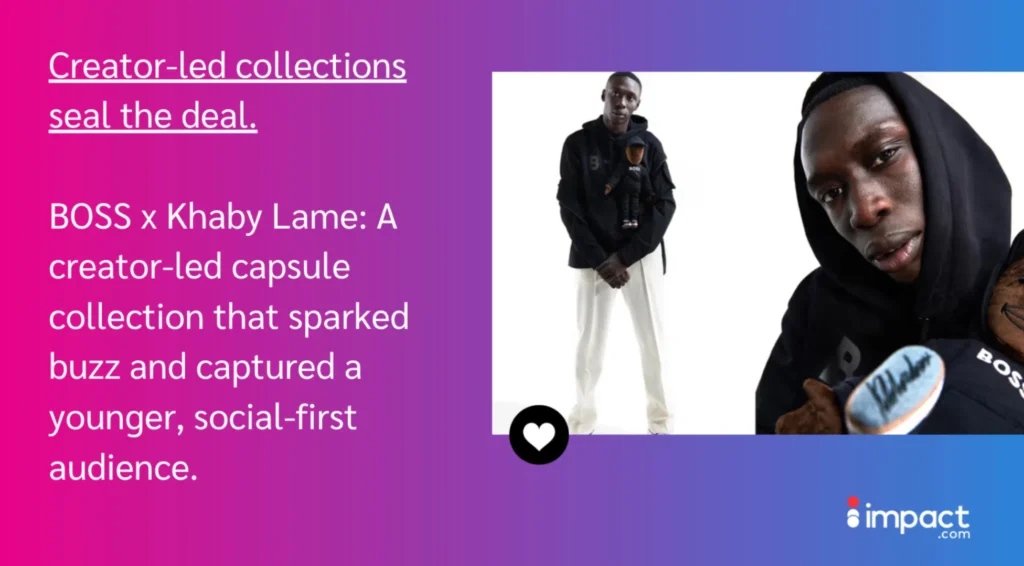
BOSS collaborates with TikTok sensation Khaby Lame to launch an exclusive capsule collection that’s sure to captivate fans and spark high demand.
BOSS x Khaby Lame collabed in 2022. The streetwear label teamed up with the viral TikTok creator to launch a limited-edition capsule collection. The drop generated massive buzz and connected BOSS with a younger, social-first audience, highlighting the power of creator-led product launches.
The future of creator commerce and branded storefronts
Creator commerce is changing, and branded storefronts are evolving alongside it. They’re becoming more dynamic, data-driven, and immersive. New technology is driving this shift, making shopping more engaging while strengthening the connection between creators and brands
Smarter tech, sharper user experiences
The next wave of creator commerce will be powered by advanced tools like AI-driven product recommendations, AR-enabled try-ons, and live shopping integrations. These innovations make storefronts more interactive and personalized.
Crate & Barrel offers an AR feature called View in My Room, which lets customers use their smartphone to see how over 5,000 items would look in their actual living spaces. This tool enhances the shopping experience by providing a realistic preview of furniture placement and style compatibility.
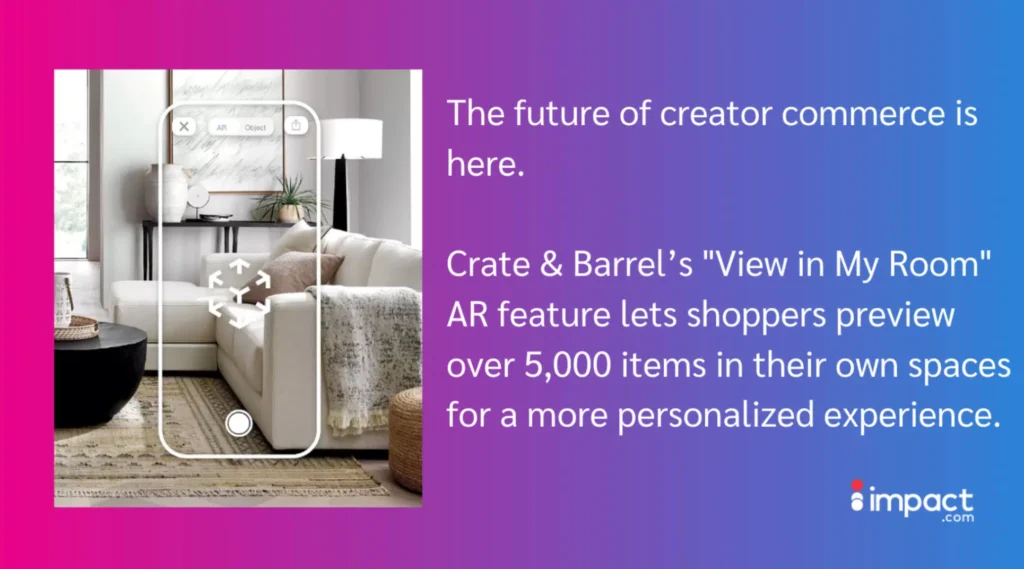
Crate & Barrel is stepping into the future with AI-powered features like “View In My Room,” allowing users to seamlessly visualize products in their space.
Global growth of social commerce
Markets like China have shown what’s possible, with creator content favored by 89 percent of local users. A prime example of this trend, and the global growth of social commerce, is the live-streaming platform Taobao Live. The social commerce platform combines entertainment and shopping through engaging content.
Now, emerging markets are catching up. It provides global brands the chance to launch region-specific storefronts that match local trends, habits, and languages.
Deeper engagement through creator-led connections
Branded storefronts are about relationships as much as transactions. Tools like direct messaging, live creator events, and UGC give brands new ways to engage audiences in real time.
For instance, a beauty brand could host live Q&As with a creator inside its storefront, turning product curiosity into conversation and, ultimately, conversion.
Branded storefronts with short-form content create the ultimate shopping experience
Branded storefronts, whether on platforms like Amazon or within custom apps, often include features for short-form content.
Quick, engaging formats like short videos are an effective way to capture customer attention.
Research shows that short-form videos are preferred worldwide by 63 percent of social users, making them a powerful tool for engagement. When paired with branded storefronts, they can create the ultimate shopping experience.
Live shopping integrations
Real-time product demonstrations through storefront live streams
Live shopping brings the in-store experience directly to consumers’ devices. Brands can host live demonstrations within their storefronts, showcasing products in action and providing immediate insights.
In real life, a fitness brand might stream a live workout session and feature trainers using its equipment. That way viewers can see the products’ functionality and benefits firsthand.
Interactive Q&A sessions
Engaging directly with consumers through live Q&A sessions fosters trust and addresses potential hesitations.
A tech influencer could host live walkthroughs of a new gadget and answer viewer questions in real-time. This would simplify the decision-making process for potential buyers.
Limited-time offers during live events
Introducing exclusive deals during live streams creates urgency and encourages immediate purchases.
Canvas Beauty founder Stormi Steele hosted a record-breaking, six-hour TikTok Live session that generated over $1 million in sales.
During the livestream, Steele engaged viewers with real-time demonstrations and exclusive, limited-time offers on popular products like the Body Glaze line. Taking this approach created a direct connection with the audience, turning product curiosity into immediate conversions.
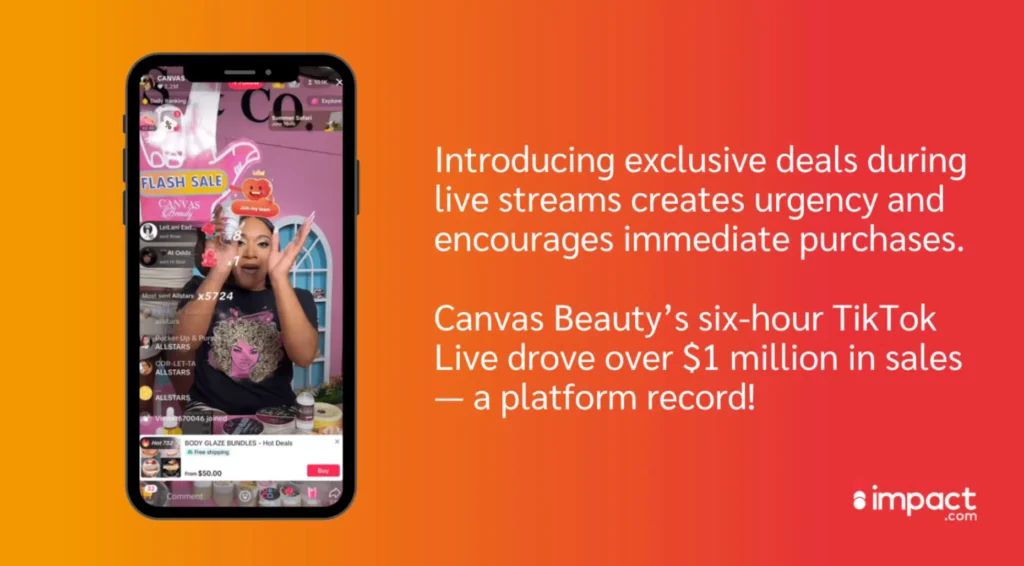
Canva Beauty’s six-hour live event shattered records, generating over $1 million in sales through exclusive deals.
Seamless integration with social platforms
Using APIs from platforms like TikTok and Instagram lets brands create cohesive shopping experiences. Users can view products, interact with hosts, and complete purchases without leaving the app, streamlining the customer journey.
Branded storefronts and advanced social selling features
Today’s most effective branded storefronts do more than look good. They’re powered by advanced features that enhance personalization, build trust, and drive conversions.
AI-powered product recommendations
AI algorithms help personalize the user experience by analyzing user behavior, preferences, and purchase history. This leads to smarter suggestions that can increase cart value and improve the user journey.
Amazon’s “Frequently Bought Together” and “Customers Also Bought” features are classic use cases that drive additional purchases through smart bundling.
Brand consideration: Setting up these systems can require a significant upfront investment in data infrastructure and ongoing optimization for recommendations to stay relevant.
Social proof integration (Reviews, UGC)
Including reviews, ratings, and user-generated content in storefronts helps build trust. Real visuals, such as before-and-after photos or video testimonials, let shoppers see how products look and work in everyday life, not just polished ads.
Brand consideration: Moderating UGC for quality, compliance, and brand safety requires the right technology or dedicated time and resources, especially at scale.
Community building through group discounts
Group buying tools and shared discounts help storefronts foster community and drive larger purchases.
Brand consideration: Group-buying tools need careful configuration and may require integrations with third-party platforms. Tracking fulfillment and discounts across users can also get complex.
Cross-platform synchronization
Synchronizing promotions across TikTok, Instagram, Pinterest, and Facebook ensures audiences see consistent messaging wherever they interact with the brand.
Picture a fashion label rolling out a seasonal campaign across paid ads, influencer storefronts, and organic posts to maintain a cohesive presence.
Brand consideration: Managing content and inventory across multiple platforms requires coordination. Stock mismatches or outdated creative assets can damage trust and cause confusion.
Technical considerations to keep in mind
While branded storefronts offer clear benefits, launching and maintaining them presents a few challenges that brands should consider.
Technical integration can be complex
Connecting a storefront to existing e-commerce systems, affiliate platforms, or social commerce tools may require custom development or third-party support, especially if you manage multiple creators or storefronts simultaneously.
It takes time, budget, and internal expertise
Setting up a branded storefront isn’t always plug-and-play.
Brands need people who understand both the tech and the creative side, from setting up tracking links to aligning the storefront with brand guidelines.
Managing content and inventory can get messy
To keep storefronts current, brands need to sync product availability, pricing, and creative assets across multiple channels. Without the right tools, updates can become time-consuming and prone to errors.
Platform policies are always changing
Social commerce platforms regularly update their guidelines, algorithms, and feature sets. What works today might need to be reconfigured tomorrow, so flexibility is key.
Despite these challenges, many brands find the long-term payoff worth it. The key is being realistic about what it takes and having a plan in place to manage the moving parts.
FAQs
A branded storefront is an online or physical retail space that showcases a brand’s unique identity, style, and message. It gives brands a way to connect directly with customers while keeping the experience consistent across all channels.
Branded storefronts help build trust, boost visibility, and strengthen customer loyalty. They’re a powerful way for businesses to stand out in a crowded market.
Creator commerce is a business model where creators, influencers, and entrepreneurs earn money by selling directly to their audiences. By using social media, digital tools, and e-commerce platforms, they can turn their content, products, or services into profitable ventures, built around the communities they’ve cultivated.
Successful branded storefronts combine strong branding, easy checkout, and engaging features like live interactions and personalized recommendations. Together, these elements create a smooth, user-friendly experience that builds trust, makes shopping simple, and encourages repeat purchases.
Branded storefronts bridge the gap between online and offline experiences, making them a key part of any omnichannel strategy. They simplify inventory management, support click-and-collect options, and create consistent touchpoints, giving customers a seamless experience across every channel.
Branded storefronts keep brands at the forefront of creator commerce
Branded storefronts are revolutionizing the way brands sell, creators share, and consumers shop. By combining the influence of creators with personalized, shoppable experiences, these storefronts meet today’s customers exactly where they are—online and ready to engage.
This innovative approach is transforming e-commerce by building trust through curated collections, driving instant purchases via live-streaming, and creating frictionless paths to purchase. It’s not just a strategy—it’s a shift in how brands connect with audiences, fostering deeper relationships and faster growth.
The impact is undeniable. Branded storefronts create a win-win ecosystem: brands enjoy higher sales and stronger customer loyalty, creators establish credibility while earning commissions, and consumers gain confidence in discovering new products with ease.
Embracing branded storefronts is no longer optional—it’s the key to staying relevant in today’s consumer-driven landscape. By leveraging the power of influence, personalization, and convenience, brands can position themselves at the forefront of this retail evolution.
Ready to turn creator partnerships into real performance?
Get started with impact.com and see how branded storefronts can take your creator commerce strategy to the next level.
Check out more content here:
- 8 influencer marketing trends for 2025: 11 experts reveal how to increase ROI with performance-driven creator partnerships (blog)
- Exploring the Business Side of TikTok (podcast)
- The ultimate guide to influencer marketing in 2025 (blog)
- 4 research-backed ways content creators can increase buyer intent (blog)
- TikTok Triumph: Mastering Affiliate Strategy to Boost Sales and Success (free course)
